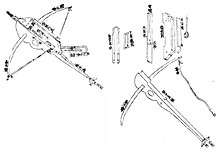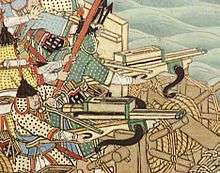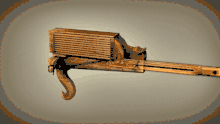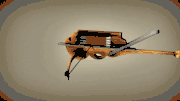Repeating crossbow
| Repeating crossbow | |||||||||||||||||||||||
 The earliest extant repeating crossbow, a double-shot repeating crossbow excavated from a tomb of the State of Chu, 4th century BC | |||||||||||||||||||||||
| Traditional Chinese | 諸葛弩 | ||||||||||||||||||||||
|---|---|---|---|---|---|---|---|---|---|---|---|---|---|---|---|---|---|---|---|---|---|---|---|
| Simplified Chinese | 诸葛弩 | ||||||||||||||||||||||
| Literal meaning | "Zhuge [Liang] crossbow" | ||||||||||||||||||||||
| |||||||||||||||||||||||
The repeating crossbow (Chinese: 連弩; pinyin: Lián Nŭ) is a Chinese crossbow that was invented during the warring states period, and remained in use until the late Qing dynasty. The repeating crossbow combined into a one-handed movement, the actions of stringing the bow, placing the bolt and shooting, thus allowing for a much higher rate of fire than a normal crossbow. A top-mounted magazine containing a reservoir of bolts fed the crossbow through gravity, and the mechanism was worked by moving a rectangular lever forward and backward.
It is also known as the Zhuge crossbow (Chinese: 諸葛弩; pinyin: Zhūgé nǔ, also romanized Chu-ko-nu) due to its association with the Three Kingdoms-era strategist Zhuge Liang (181–234 AD),
History



The Zhuge Nu is a handy little weapon that even the Confucian scholar or palace women can use in self-defence... It fires weakly so you have to tip the darts with poison. Once the darts are tipped with "tiger-killing poison", you can shoot it at a horse or a man and as long as you draw blood, your adversary will die immediately. The draw-back to the weapon is its very limited range.[1]
According to the Wu-Yue Chunqiu (history of the Wu-Yue War), written in the Eastern Han dynasty, the repeating crossbow was invented during the Warring States Period by a Mr. Qin from the State of Chu. This is corroborated by the earliest archaeological evidence of repeating crossbows, which was excavated from a Chu burial site at Tomb 47 at Qinjiazui, Hubei Province, and has been dated to the 4th century BC, during the Warring States Period (475 - 220 BC).[2] Unlike repeating crossbows of later eras, the ancient double shot repeating crossbow uses a pistol grip and a rear pulling mechanism for arming. The Ming repeating crossbow uses an arming mechanism which requires its user to push a rear lever upwards and downwards back and forth.[3] Although hand held repeating crossbows were generally weak and required additional poison, probably aconite, for lethality, much larger mounted versions appeared during the Ming dynasty.[1]
In 180 AD, Yang Xuan used a type of repeating crossbow powered by the movement of wheels:
...around A.D. 180 when Yang Xuan, Grand Protector of Lingling, attempted to suppress heavy rebel activity with badly inadequate forces. Yang's solution was to load several tens of wagons with sacks of lime and mount automatic crossbows on others. Then, deploying them into a fighting formation, he exploited the wind to engulf the enemy with clouds of lime dust, blinding them, before setting rags on the tails of the horses pulling these driverless artillery wagons alight. Directed into the enemy's heavily obscured formation, their repeating crossbows (powered by linkage with the wheels) fired repeatedly in random directions, inflicting heavy casualties. Amidst the obviously great confusion the rebels fired back furiously in self-defense, decimating each other before Yang's forces came up and largely exterminated them.[4]
— Ralph Sawyer
The invention of the repeating crossbow has often been attributed to Zhuge Liang, but he in fact had nothing to do with it. This misconception is based on a record attributing improvements to the multiple bolt crossbows to him.[5]
During the Ming dynasty, repeating crossbows were used on ships.[4]
Repeating crossbows continued in use until the late Qing dynasty when it became obvious they could not longer compete with firearms.[4]
Utility
Fired from the hip, the bolts were fired in sequence from pumping the corking lever forward and backward, arming and releasing in a continuous cyclic process until the magazine was emptied. This rocking action did not allow for precise firing, nor did the inability to sight along the barrel as in a crossbow or a modern gun.[4]
— Liang Jieming
The basic construction of the repeating crossbow has remained very much unchanged since its invention, making it one of the longest-lived mechanical weapons. The bolts of one magazine are fired and reloaded by simply pushing and pulling the lever back and forth.[6]
The repeating crossbow had an effective range of 70 meters and a maximum range of 180 meters.[7] Its comparatively short range limited its usage to primarily defensive positions, where its ability to rapidly discharge 7–10 bolts in 15–20 seconds was used to prevent assaults on gates and doorways.[4] In comparison, an arbalest could only deliver about two bolts a minute. The repeating crossbow, with its smaller and lighter ammunition, had neither the power nor the accuracy of an arbalest. Thus, it was not very useful against more heavily armoured troops unless poison was smeared on bolts, in which case even a small wound might prove fatal.[6]
Gallery
 The earliest extant repeating crossbow, a double-shot repeating crossbow excavated from a tomb of the State of Chu, 4th century BC.
The earliest extant repeating crossbow, a double-shot repeating crossbow excavated from a tomb of the State of Chu, 4th century BC. Double shot repeating crossbow, also known as the Chu state repeating crossbow (chuguo nu)
Double shot repeating crossbow, also known as the Chu state repeating crossbow (chuguo nu) Repeating crossbow from the Wubei Zhi, also known as the Zhuge repeating crossbow (Zhuge nu)
Repeating crossbow from the Wubei Zhi, also known as the Zhuge repeating crossbow (Zhuge nu) Ming repeating crossbow trigger mechanism
Ming repeating crossbow trigger mechanism
See also
Notes
- 1 2 Loades 2018.
- ↑ Lin, Yun. "History of the Crossbow," in Chinese Classics & Culture, 1993, No.4: p. 33–37.
- ↑ Unique weapon of the Ming Dynasty — Zhu Ge Nu (諸葛弩), retrieved 16 April 2018
- 1 2 3 4 5 Liang 2006.
- ↑ Needham 1994, p. 8.
- 1 2 Gallwey, Sir Ralph (1990). "The Crossbow" (Ninth Impression ed.). The Holland Press. p. 337.
- ↑ Needham 1994, p. 176.
Works cited
- Liang, Jieming (2006), Chinese Siege Warfare: Mechanical Artillery & Siege Weapons of Antiquity, Singapore, Republic of Singapore: Leong Kit Meng, ISBN 981-05-5380-3
- Needham, Joseph (1994), Science and Civilization in China Volume 5 Part 6, Cambridge University Press
Bibliography
- Adle, Chahryar (2003), History of Civilizations of Central Asia: Development in Contrast: from the Sixteenth to the Mid-Nineteenth Century
- Ágoston, Gábor (2005), Guns for the Sultan: Military Power and the Weapons Industry in the Ottoman Empire, Cambridge University Press, ISBN 0-521-60391-9
- Agrawal, Jai Prakash (2010), High Energy Materials: Propellants, Explosives and Pyrotechnics, Wiley-VCH
- Andrade, Tonio (2016), The Gunpowder Age: China, Military Innovation, and the Rise of the West in World History, Princeton University Press, ISBN 978-0-691-13597-7 .
- Arnold, Thomas (2001), The Renaissance at War, Cassell & Co, ISBN 0-304-35270-5
- Benton, Captain James G. (1862). A Course of Instruction in Ordnance and Gunnery (2 ed.). West Point, New York: Thomas Publications. ISBN 1-57747-079-6.
- Brown, G. I. (1998), The Big Bang: A History of Explosives, Sutton Publishing, ISBN 0-7509-1878-0 .
- Buchanan, Brenda J., ed. (2006), Gunpowder, Explosives and the State: A Technological History, Aldershot: Ashgate, ISBN 0-7546-5259-9
- Chase, Kenneth (2003), Firearms: A Global History to 1700, Cambridge University Press, ISBN 0-521-82274-2 .
- Cocroft, Wayne (2000), Dangerous Energy: The archaeology of gunpowder and military explosives manufacture, Swindon: English Heritage, ISBN 1-85074-718-0
- Cook, Haruko Taya (2000), Japan At War: An Oral History, Phoenix Press
- Cowley, Robert (1993), Experience of War, Laurel .
- Cressy, David (2013), Saltpeter: The Mother of Gunpowder, Oxford University Press
- Crosby, Alfred W. (2002), Throwing Fire: Projectile Technology Through History, Cambridge University Press, ISBN 0-521-79158-8 .
- Curtis, W. S. (2014), Long Range Shooting: A Historical Perspective, WeldenOwen .
- Earl, Brian (1978), Cornish Explosives, Cornwall: The Trevithick Society, ISBN 0-904040-13-5 .
- Easton, S. C. (1952), Roger Bacon and His Search for a Universal Science: A Reconsideration of the Life and Work of Roger Bacon in the Light of His Own Stated Purposes, Basil Blackwell
- Ebrey, Patricia B. (1999), The Cambridge Illustrated History of China, Cambridge University Press, ISBN 0-521-43519-6
- Grant, R.G. (2011), Battle at Sea: 3,000 Years of Naval Warfare, DK Publishing .
- Hadden, R. Lee. 2005. "Confederate Boys and Peter Monkeys." Armchair General. January 2005. Adapted from a talk given to the Geological Society of America on March 25, 2004.
- Harding, Richard (1999), Seapower and Naval Warfare, 1650-1830, UCL Press Limited
- al-Hassan, Ahmad Y. (2001), "Potassium Nitrate in Arabic and Latin Sources", History of Science and Technology in Islam, retrieved 23 July 2007 .
- Hobson, John M. (2004), The Eastern Origins of Western Civilisation, Cambridge University Press .
- Johnson, Norman Gardner. "explosive". Encyclopædia Britannica. Chicago: Encyclopædia Britannica Online.
- Kelly, Jack (2004), Gunpowder: Alchemy, Bombards, & Pyrotechnics: The History of the Explosive that Changed the World, Basic Books, ISBN 0-465-03718-6 .
- Khan, Iqtidar Alam (1996), "Coming of Gunpowder to the Islamic World and North India: Spotlight on the Role of the Mongols", Journal of Asian History, 30: 41–5 .
- Khan, Iqtidar Alam (2004), Gunpowder and Firearms: Warfare in Medieval India, Oxford University Press
- Khan, Iqtidar Alam (2008), Historical Dictionary of Medieval India, The Scarecrow Press, Inc., ISBN 0-8108-5503-8
- Kinard, Jeff (2007), Artillery An Illustrated History of its Impact
- Konstam, Angus (2002), Renaissance War Galley 1470-1590, Osprey Publisher Ltd. .
- Lidin, Olaf G. (2002), Tanegashima – The Arrival of Europe in Japan, Nordic Inst of Asian Studies, ISBN 8791114128
- Lorge, Peter A. (2008), The Asian Military Revolution: from Gunpowder to the Bomb, Cambridge University Press, ISBN 978-0-521-60954-8
- Lu, Gwei-Djen (1988), "The Oldest Representation of a Bombard", Technology and Culture, 29: 594–605
- May, Timothy (2012), The Mongol Conquests in World History, Reaktion Books
- McLahlan, Sean (2010), Medieval Handgonnes
- McNeill, William Hardy (1992), The Rise of the West: A History of the Human Community, University of Chicago Press .
- Morillo, Stephen (2008), War in World History: Society, Technology, and War from Ancient Times to the Present, Volume 1, To 1500, McGraw-Hill, ISBN 978-0-07-052584-9
- Needham, Joseph (1971), Science and Civilization in China Volume 4 Part 3, Cambridge At The University Press
- Needham, Joseph (1980), Science & Civilisation in China, 5 pt. 4, Cambridge University Press, ISBN 0-521-08573-X
- Needham, Joseph (1986), Science & Civilisation in China, V:7: The Gunpowder Epic, Cambridge University Press, ISBN 0-521-30358-3 .
- Nicolle, David (1990), The Mongol Warlords: Ghengis Khan, Kublai Khan, Hulegu, Tamerlane
- Nolan, Cathal J. (2006), The Age of Wars of Religion, 1000–1650: an Encyclopedia of Global Warfare and Civilization, Vol 1, A-K, 1, Westport & London: Greenwood Press, ISBN 0-313-33733-0
- Norris, John (2003), Early Gunpowder Artillery: 1300–1600, Marlborough: The Crowood Press .
- Partington, J. R. (1960), A History of Greek Fire and Gunpowder, Cambridge, UK: W. Heffer & Sons .
- Partington, J. R. (1999), A History of Greek Fire and Gunpowder, Baltimore: Johns Hopkins University Press, ISBN 0-8018-5954-9
- Patrick, John Merton (1961), Artillery and warfare during the thirteenth and fourteenth centuries, Utah State University Press .
- Pauly, Roger (2004), Firearms: The Life Story of a Technology, Greenwood Publishing Group .
- Perrin, Noel (1979), Giving up the Gun, Japan's reversion to the Sword, 1543–1879, Boston: David R. Godine, ISBN 0-87923-773-2
- Petzal, David E. (2014), The Total Gun Manual (Canadian edition), WeldonOwen .
- Phillips, Henry Prataps (2016), The History and Chronology of Gunpowder and Gunpowder Weapons (c.1000 to 1850), Notion Press
- Purton, Peter (2010), A History of the Late Medieval Siege, 1200–1500, Boydell Press, ISBN 1-84383-449-9
- Robins, Benjamin (1742), New Principles of Gunnery
- Rose, Susan (2002), Medieval Naval Warfare 1000-1500, Routledge
- Roy, Kaushik (2015), Warfare in Pre-British India, Routledge
- Schmidtchen, Volker (1977a), "Riesengeschütze des 15. Jahrhunderts. Technische Höchstleistungen ihrer Zeit", Technikgeschichte 44 (2): 153–173 (153–157)
- Schmidtchen, Volker (1977b), "Riesengeschütze des 15. Jahrhunderts. Technische Höchstleistungen ihrer Zeit", Technikgeschichte 44 (3): 213–237 (226–228)
- Tran, Nhung Tuyet (2006), Viêt Nam Borderless Histories, University of Wisconsin Press .
- Turnbull, Stephen (2001), Siege Weapons of the Far East (1) AD 612-1300, Osprey Publishing
- Turnbull, Stephen (2002), Siege Weapons of the Far East (2) AD 960-1644, Osprey Publishing
- Turnbull, Stephen (2003), Fighting Ships Far East (2: Japan and Korea Ad 612-1639, Osprey Publishing, ISBN 1-84176-478-7
- Urbanski, Tadeusz (1967), Chemistry and Technology of Explosives, III, New York: Pergamon Press .
- Villalon, L. J. Andrew (2008), The Hundred Years War (part II): Different Vistas, Brill Academic Pub, ISBN 978-90-04-16821-3
- Wagner, John A. (2006), The Encyclopedia of the Hundred Years War, Westport & London: Greenwood Press, ISBN 0-313-32736-X
- Watson, Peter (2006), Ideas: A History of Thought and Invention, from Fire to Freud, Harper Perennial (2006), ISBN 0-06-093564-2
- Wilkinson, Philip (9 September 1997), Castles, Dorling Kindersley, ISBN 978-0-7894-2047-3
- Wilkinson-Latham, Robert (1975), Napoleon's Artillery, France: Osprey Publishing, ISBN 0-85045-247-3
- Willbanks, James H. (2004), Machine guns: an illustrated history of their impact, ABC-CLIO, Inc.
- Williams, Anthony G. (2000), Rapid Fire, Shrewsbury: Airlife Publishing Ltd., ISBN 1-84037-435-7